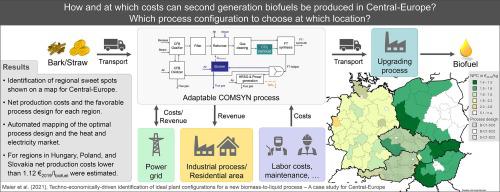Energy Conversion and Management ( IF 10.4 ) Pub Date : 2021-09-16 , DOI: 10.1016/j.enconman.2021.114651 Simon Maier 1 , Sanna Tuomi 2 , Johanna Kihlman 2 , Esa Kurkela 2 , Ralph-Uwe Dietrich 1

|
The conversion of agricultural waste materials such as bark or straw into 2nd generation biofuels constitutes an auspicious way to meet part of the future fuel demand in a sustainable way. The number of possible production routes is diverse, and the techno-economic analyses of these routes have been conducted in very different ways. The route involving gasification, gas purification, and a subsequent Fischer-Tropsch synthesis enables the production of hydrocarbons that achieve current fuel standards after upgrading in the existing refinery infrastructure. To evaluate a promising biomass-to-liquid process, a methodology is presented that incorporates economic constraints into the process design, allowing identification of a regionally optimal process design. The production costs of the new concepts are estimated by setting up a detailed flowsheet simulation in AspenPlus® based on experimental data from the successful demonstration runs of the EU-Project COMSYN. In addition, an existing techno-economic evaluation methodology incorporated into the in-house software tool TEPET (Techno-Economic Process Evaluation Tool) has been extended to evaluate the processes’ performance in different European regions and to include transportation and refining costs. The approach enables the identification of regional sweet spots shown on a map for Central-Europe, indicating production costs and favorable process design for each region. Furthermore, the results of an automated mapping for the optimal process design depending on the heat and electricity market are presented. The performed analyses show that the techno-economic evaluation tends to expand the technology in regions with low feedstock costs, while the optimal process design is defined by the regional heat and electricity market. In this work, net production costs of less than 1.12 €2019/lbiofuel were determined for regions in Hungary, Poland and Slovakia.
中文翻译:

技术经济驱动的新型生物质液化工艺理想工厂配置的确定——中欧案例研究
将树皮或秸秆等农业废料转化为第二代生物燃料是一种以可持续方式满足部分未来燃料需求的吉祥方式。可能的生产路线的数量多种多样,对这些路线的技术经济分析以非常不同的方式进行。这条涉及气化、气体净化和随后的费-托合成的路线使现有炼油厂基础设施升级后能够生产达到当前燃料标准的碳氢化合物。为了评估有前景的生物质液化工艺,提出了一种将经济约束纳入工艺设计的方法,允许确定区域最佳工艺设计。根据欧盟项目 COMSYN 成功示范运行的实验数据,通过在 AspenPlus® 中设置详细的流程模拟来估算新概念的生产成本。此外,纳入内部软件工具 TEPET(技术经济过程评估工具)的现有技术经济评估方法已扩展到评估不同欧洲地区的过程绩效,并包括运输和炼油成本。该方法能够识别中欧地图上显示的区域最佳点,表明每个区域的生产成本和有利的工艺设计。此外,还介绍了根据热力和电力市场优化过程设计的自动映射结果。分析表明,技术经济评价倾向于在原料成本低的地区推广技术,而最佳工艺设计则由地区热电市场确定。在这项工作中,净生产成本低于 1.12 欧元匈牙利、波兰和斯洛伐克的地区确定了2019 /l生物燃料。



























 京公网安备 11010802027423号
京公网安备 11010802027423号